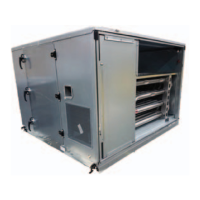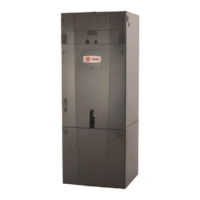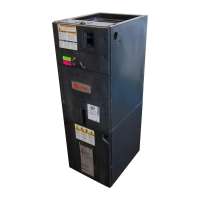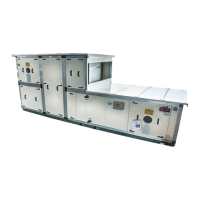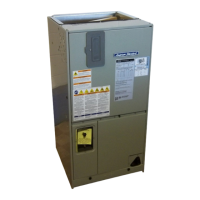Start Up
28 CLCH-SVX08C-EN
Main Burner Ignition
(3:1, 10:1 Turndown, 200-2000 MBh)
1. With the manual disconnect switch in the gas heat
control panel in the Off position, open the second
manual gas valve located downstream of the
modulating gas valve.
2. Turn the manual disconnect switch to the On position.
After the pre-purge and pilot cycle, the main gas valve
will energize and the main burner will light.
3. The flame can be observed through the larger sight
glass under the burner (or opposite side of drum on
size 200). The normal flame color is blue with yellow
tips; abnormal color is yellow. Yellow indicates a need
for adjustments by a qualified technician.
4. Check the flame-signal strength from the ultra-violet
sensor. A 0 to 15 Vdc, 10K ohm (minimum) voltmeter
is required.
5. Insert the positive probe of the voltmeter into the
positive (+) flame-signal test point on the flame relay
cover.
6. Connect the negative probe to the negative (-) test
point on the flame relay cover. Table 8 shows the
desired signal strengths.
7. Allow the burner to ramp up to full fire.
Pre-Purge and Main Flame Ignition
(20:1 Turndown, 1250-2400 MBh)
With the manual gas cocks closed move the manual
disconnect switch in the heater vestibule to the ON
position. The system should energize, and the combustion
blower motor should start, indicating that all of the safety/
limit contacts are closed:
• HLI1: high-temperature limit
• AI1: airflow interlock
• HPGS1: high-pressure gas switch
• LPGS1: low-pressure gas switch
The combustion airflow switch (CAFS1) should close,
starting the purge timer, the green power light should
illuminate on the flame-relay panel, and the prepurge
cycle should begin. The combustion air blower should run
for approximately 90 seconds to evacuate the heat
exchanger of any combustible gases before the ignition
sequence. This prepurge cycle is initiated before every
startup.
At the end of the purge cycle, the ignition transformer and
automatic gas valves will energize. With the manual gas
cocks closed, the burner should go into a safety lockout
condition. The flame safeguard will have to be reset
manually. Turn the manual disconnect switch in the
control panel to the OFF position.
Note: Prior to opening the manual gas cock make certain
the modulating gas linkage is set to operate in all
positions without binding.
1. Turn the manual disconnect switch in the control panel
to the ON position. After the prepurge sequence is
complete the ignition transformer will energize
providing ignition spark and the main automatic gas
valves will open. With the ignition spark energized and the
automatic gas valve open, slowly open the manual gas
shut off cocks. Flame should be established. (Make sure
the modulating gas valve is adequately open).
2. At initial start up, air may be trapped in the gas lines so
more than one attempt to light off may be required. Do
not allow unburned gas to accumulate in the
combustion chamber.
3. Once flame is established run the mod motor to
position the modulating gas valve wide open.
4. The amber Main Flame light should illuminate on the
flame relay panel after the ultra-violet flame sensor has
detected the main flame. The flame can be observed
through the larger sight glass under the burner.
Normal flame color is blue with yellow tips; abnormal
color is yellow, indicating a need for adjustments by a
qualified technician. Note that smaller sized heaters
have the sight glass on the side opposite the piping
connection side.
5. Check the flame-signal strength from the flame rod. A
0 to 15 Vdc, 1 megohm/volt (minimum) meter is
required.
6. Insert the positive probe of the voltmeter into the
positive (+) flame-signal test point on the flame relay
cover.
7. Connect the negative probe to the negative (-) test
point on the flame relay cover. Flame signal strength
should be a steady dc voltage between 1.25 and 5.0
volts.
8. Allow the burner to ramp up to full fire.
Table 8. Signal strengths
Signal Strength Ultra-Violet Sensor
Good 5.0–11.0 Vdc
Marginal 1.7–5.0 Vdc
Inadequate 0.0–1.7 Vdc

